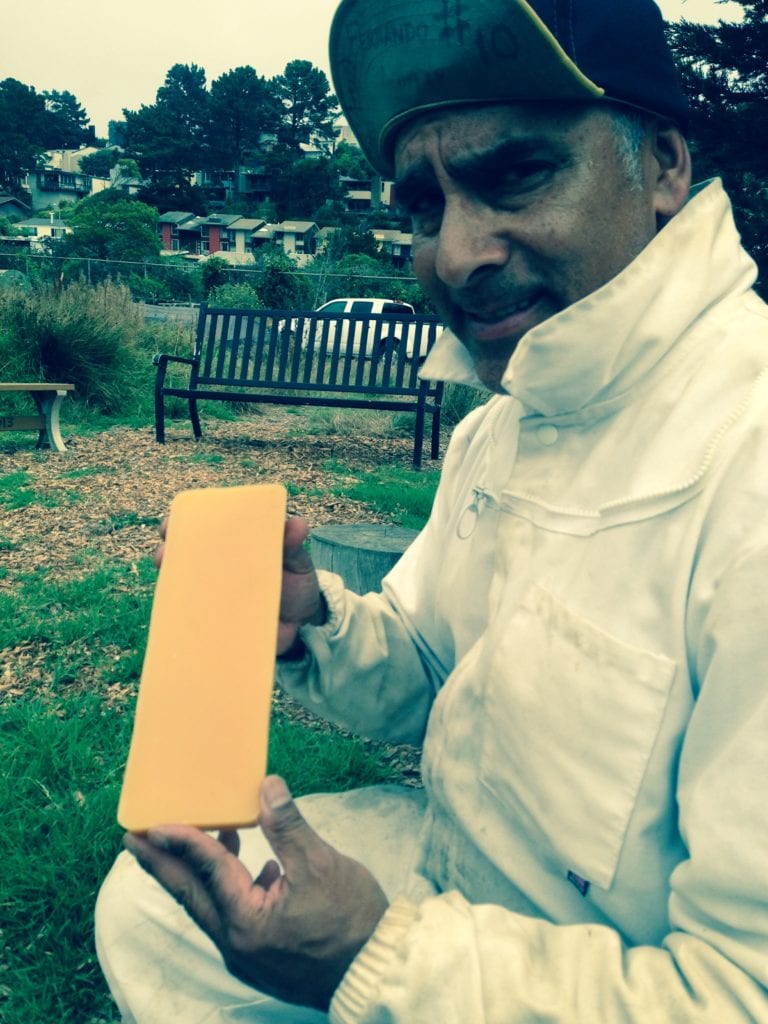
To celebrate the Glen Park Association Website turning ten years old, we are reposting some of our favorite stories from the last ten years.
Fernando Aguilar took a minute or two to suit up on the former J. Eugene McAteer High School gridiron.
The field, now home to the School Farm at the Academy of Arts and Sciences and the Ruth Asawa School of the Arts, once witnessed a 16-year old Aguilar catching spirals as a prep football wide receiver.
On an afternoon this July, Aguilar, a 1976 graduate of McAteer and a San Francisco native, eased into a uniform unlike any he’d ever worn during his four years at his alma mater.
He was preparing to harvest honey, just one byproduct of the Ecology Center of San Francisco’s collaboration with the San Francisco Unified School District.
He donned the protective clothing of an urban beekeeper, a hooded white suit, a hat and a veil.
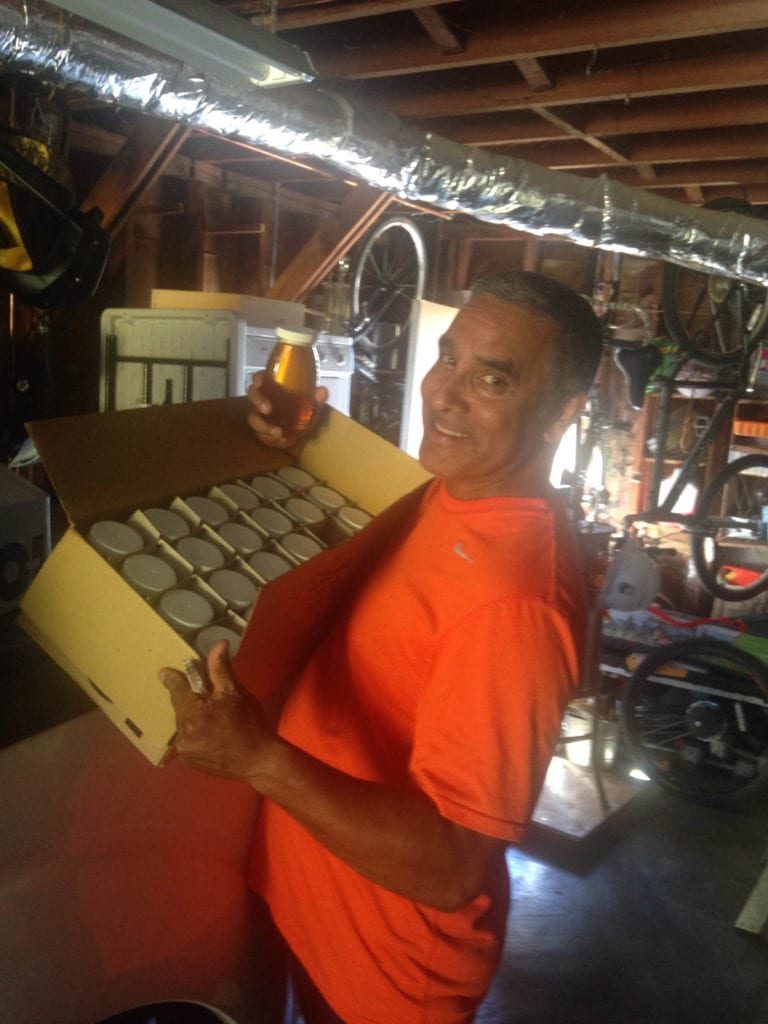
After stoking a smoker fueled by Mendocino redwood sawdust that rested on his pickup’s tailgate, he pushed his hands into a pair of gloves. In a few moments, he’d funnel smoke at circling bees surrounding his beehives, which he knew calms the honey makers.
His attire would be in service of extracting nearly 50 pounds of honey from two Student Farm hives, which, combined, house 60,000 bees that are situated on a football field where he’d once left defensive halfbacks shaking their heads in confusion as he eluded their tackles.
He’s suffered a bee’s wrath on occasion. He recently had the bad luck to have one engage him. Its sting caused both eyes to swell up, and in a day he looked as if he’d stayed the distance with Muhammad Ali.
“Honey collection is seasonal,” he said, on a happier note. “I harvest in the spring, summer and fall, although some beekeepers do so in the winter due to the blossoming of eucalyptus trees.”
A sweet deal, some would say, particularly anyone who has patronized the ECOSF’s Tuesday afternoon farmer’s stand and purchased a pound of fresh-out-of-the-hive honey.
The price for a 16-ounce jar would make a Bi-Rite store manager’s blood sugar rise.
It was two years ago when Aguilar first happened on the Student Farm, which also produces chard, cabbage, kale and zucchini and raises yarrow, poppies and primrose. It boasts 20 egg-laying hens, as well.
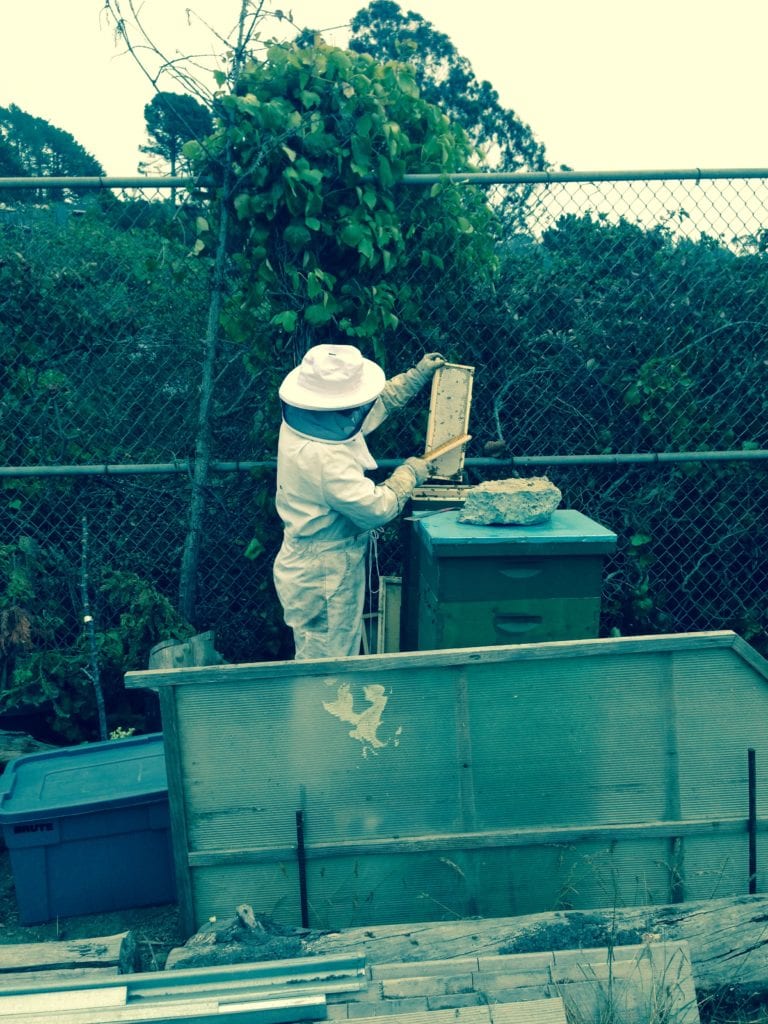
“On Sundays, I’d jump the fence and run in preparation for Bay to Breakers,” said Aguilar, who’s worked at PG&E for 38 years. He currently works as Project Manager and is retrofitting Glen Park’s Rousseau and Bosworth substation electrical infrastructure.
“After sprinting, I’d take a breather in the farm garden near the chicken coop and admire the serenity of it all.”
Tori Jacobs, the ECOSF Program Development director, joined him. They stood near the Student Farm greenhouse, only a few feet from his hives. Chickens clucked near them, scrabbling for feed Jacobs had just sowed.
“I care for the hens four day a week and one weekend I see this guy relaxing on our cob bench,” Jacobs said. “He’s watching the hens and asks if that’s okay.”
“I filled him in on the history of ECOSF and its many years partnering with the two high schools, and how we sell our eggs and produce each week at the O’Shaughnessy farm stand.”
He asked why they didn’t keep bees.
“We were too shorthanded to manage and properly take care of hives, I told him,” said Jacobs, “but our long term vision was to offer a certificated bee keeping program.”
“I’d admired the work of ECOSF and its no-nonsense, hands-on environmental education and awareness and was happy to donate one-hundred per cent of the honey produced by the hives to it,” said Aguilar. “Besides it’s personally cool to be keep hives at my old high school, right next to the football field where I remember having so many memories with friends another lifetime ago.”
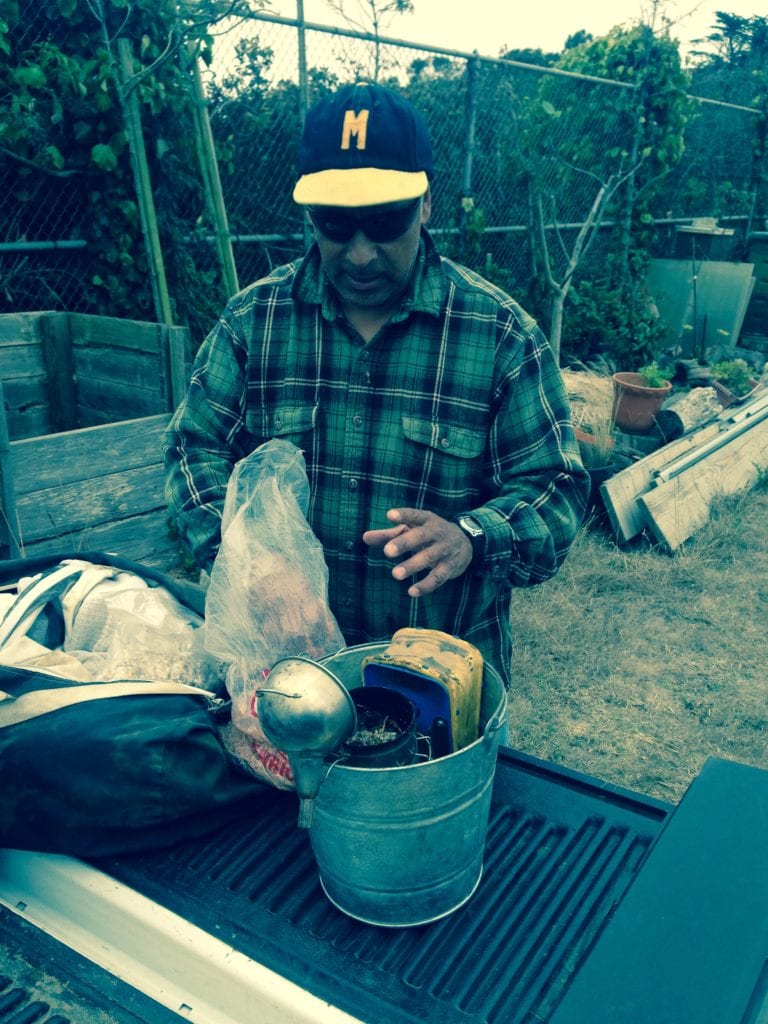
“I’d take the 35 Eureka from the house my mother rented on Jersey and Castro Streets, picking it up at 24th and Castro,” he said. “After school I’d walk home, though. I remember the City view at the top of Clipper as I rolled down the hill.”
In the two years since the Aguilar and Jacobs struck up a friendship, they’ve collaborated, not only satisfying Glen Park’s sweet tooth, but also serving up beeswax hand balm and other bee colony byproducts that Jacobs sells each Tuesday from 2:30 to 5:30 P.M.
Fully suited up now, Aguilar walked to his hives. He removed the top of one hive and quilted it with clouds of smoke, pacifying his bees.
Aguilar’s two hives are rectangular in shape, separated by numerous moveable wooden frames. Each hive consists of a roof and a floor, or the brood box. After foraging in places as far afield as Stern Grove, or as nearby as Glen Canyon his legions of bees return to their honeycombs and produce their honey and wax.
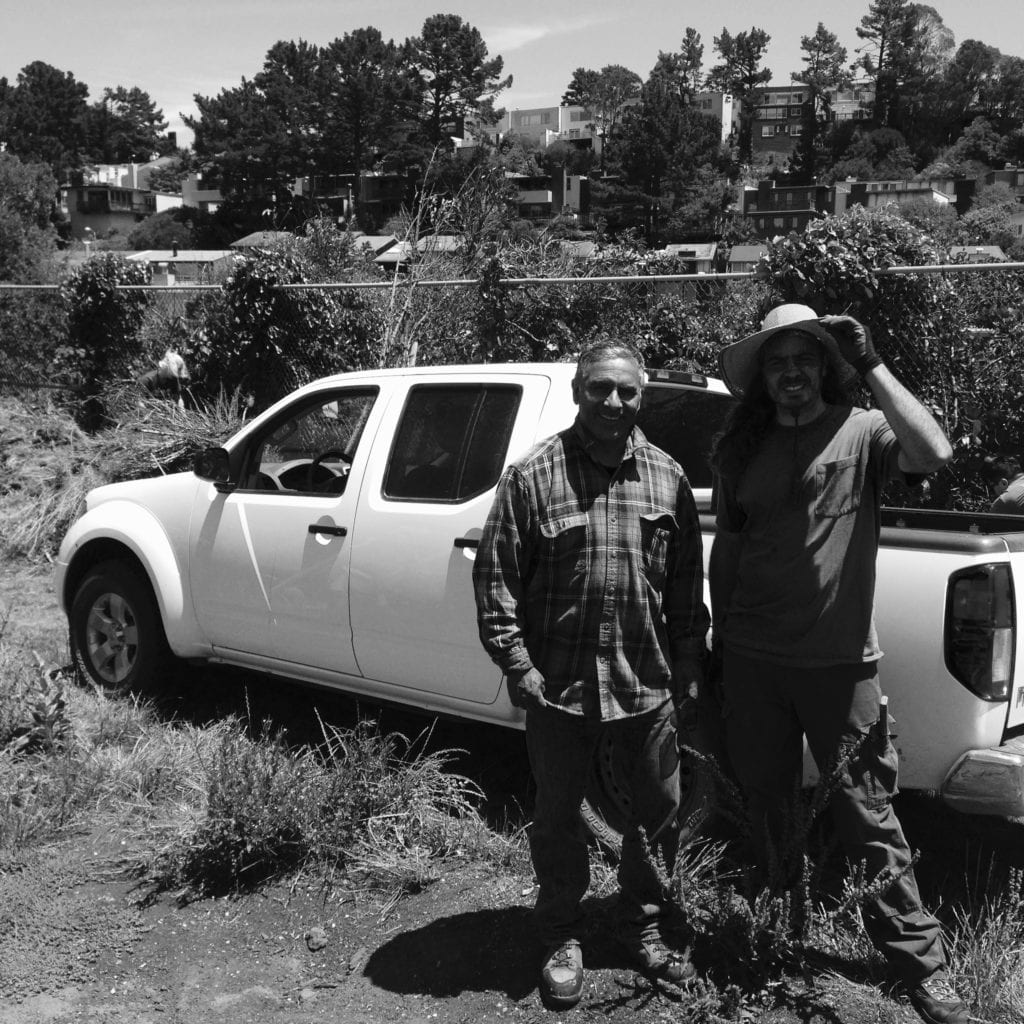
Frame by frame, Aguilar now set about harvesting the honey. He pulled out one frame at a time and held each up for inspection.
Bees blanketed each frame so that their triumvirate of honey, combs and wax intermingled in companionable silence.
Surveying one frame closely, he said, “There’re probably 200 bees clustered here.”
He took what looked like a kitchen spatula and gently pushed away the anesthetized bees. One by one, he laid the first of several frames into a Rubbermaid container. Later he’d transport it to his Bernal Heights garage where he’d extract, filter and bottle the honey for Tori Jacobs to sell for the rest of the summer or as long as her supply lasted.
It’s sticky work.
“Extracting honey is messy because you need to uncap the frames with a hot knife so the honey flows out,” he explained. “Then you put it in an extractor and then double filter it to get rid of any larva and wax.”
Over a period of one year, Aguilar’s hives produce 150 pounds of honey. While he continued clearing off frames, agitated bees landed on his arms and shoulders.
“This is the hardest part of beekeeping, keeping them from stinging,” he said. “Some are really ticked off.”
Indeed, only one week earlier, Sam Hartman, the ECOSF Program Director, who’d been supervising several farm volunteers, ran afoul of a worker bee. In its defensive mode, the drone took up unwelcome residence in Hartman’s hair. Unable to dislodge the apiary trespasser, Hartman asked a volunteer to rescue him. Flicking a pen, the senior rid Hartman of his nemesis. Hartman walked away unscathed.
In only 30 minutes, Aguilar cleared 17 frames, depositing each in his rubber made container.
“These guys can get pretty traumatized,” he said. “They like it comfy and cozy in their 98 degree hives.”
Aguilar is in the habit of leaving honey in the hive’s brood box, concentrating on only product housed in the top honey super sections of each hive.
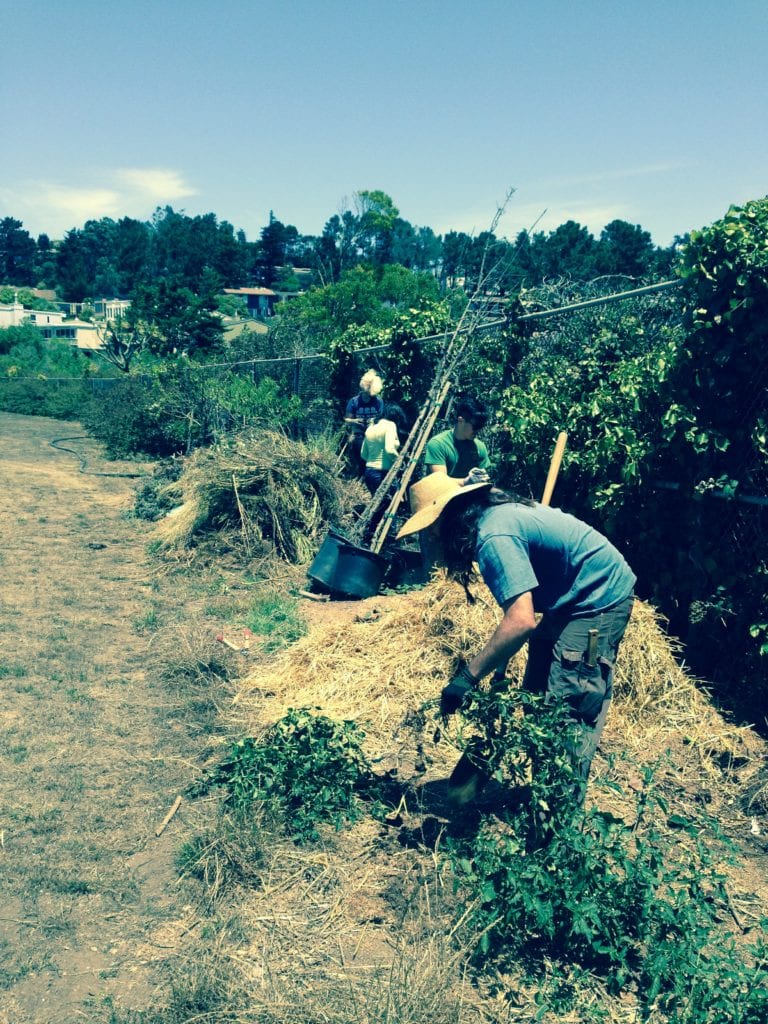
“I never want to get too greedy,” he said.
It’s all seems to fit Aguilar’s modus operandi. He’s habituated to giving back, and volunteering time with ECOSF’s Student Farm is not his only gig.
Fernando Aguilar was born in San Francisco and raised in both Noe Valley and the Mission District. The son of a Nicaraguan immigrant mother, he’s the youngest of six siblings. Early on, he was bused across town to Parkside Elementary. Later he went to Horace Mann Middle School. After attending and leaving San Francisco State University, he eventually returned, earning first a bachelor and then a Masters degre in English, all the while working for PG&E, first as an electrician and now as a project manager.
“It was a tough go for my mother, who’s now in her nineties,” said Aguilar “We didn’t have a lot.”
Each summer he spent two weeks at the San Francisco’s Boys and Girls Clubs Summer Camp in Mendocino.
Today Aguilar sits on its board of directors and returns twelve times a year to undertake projects on his own time. He oversaw and continues running the camp mountain bike program. He project managed its solar energy system that installed 78 solar panels and a battery bank that will help reduce the use of diesel generators by 30 per cent.
An amateur astronomer, he’s even brought his telescope scores of times to the California coastal camp that serves disadvantaged youth.
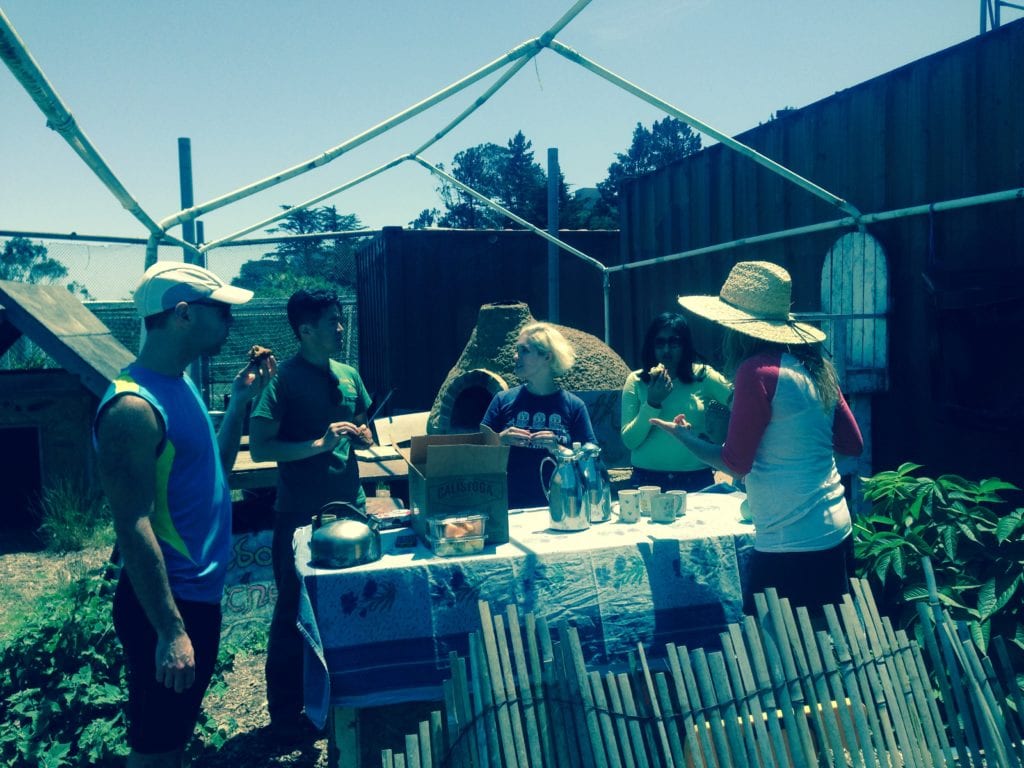
“It’s off the grid up there,” he said about the camp that one can see riding on the Skunk Train, moseying between Fort Bragg and Willits. “I installed four bee hives there three years ago. They’re surrounded by a solar powered electric fence so bears and other critters won’t destroy it. During the summer I bring my observation hive up and show the kids real bees. I have them taste honey and show them beeswax combs and candles.”
Many of Aguilar’s moonlighting activities aren’t off the grid, though.
For 20 years he’s taught English as a Second Language and Citizenship and Literacy, part time, at City College of San Francisco’s Mission Campus.
He assists legal immigrants in obtaining their American citizenship by helping them fill out their paperwork and teaches each civics and American history. He even puts on mock INS interviews, preparing them for the United States citizenship examination.
“You don’t have to be born here to be a native San Franciscan,” he said. “Anyone’s a native if he or she’s gone through the wonder years of being a five and six year old here.”
The father of two grown children who are now both attending college, he’s still finds time to maintain a beehive at the Alemany Farms, earn a certificate at the Garden for the Environment on Seventh Avenue and volunteer for the San Francisco Beekeepers Association.
His harvesting completed, he walked to his truck with the tub of frames and put it in the flatbed. Honey bees from urban beekeepers such Aguilar, some would argue, are healthier than those living their short life spans in commercial hives.
City bees face the threat of fewer pesticides and are surrounded by greater biodiversity. Flowering backyard gardens such as those found along Turquoise Way and Teresita Boulevard, both within the flight path of Aguilar’s charges, provide generous supplies of nectar and pollen for colonizing bees.
Aguilar raised his truck tailgate and secured the tub filled with his bounty.
“I first became interested in beekeeping as a natural off shoot of a garden interest I developed as a child,” he said. “I wanted bees demystified, and I think it’s neat to teach students at the Student Farm and campers in Mendocino.”
Sam Hartman of ECOSF left no doubt about Aguilar’s role giving back to the school from which he graduated.
“We get another vibrant ecological educational element on the farm to share with students and community and also dozens of pounds of fresh, local honey to sell and raise funds,” said Hartman.
“ECOSF has always depended heavily on community involvement and volunteer support, and Fernando’s contribution is like sweet honey the bees share with us.”
Readers can learn more about ECOSF by going to www.eco-sf.org Sam Hartman can be contacted at sam@eco-sf.org Readers can purchase Student Farm honey any Tuesday from 2:30-5:30 P.M. It doesn’t last long, though. Readers can learn more about Camp Mendocino by going to www.campmendocino.org.